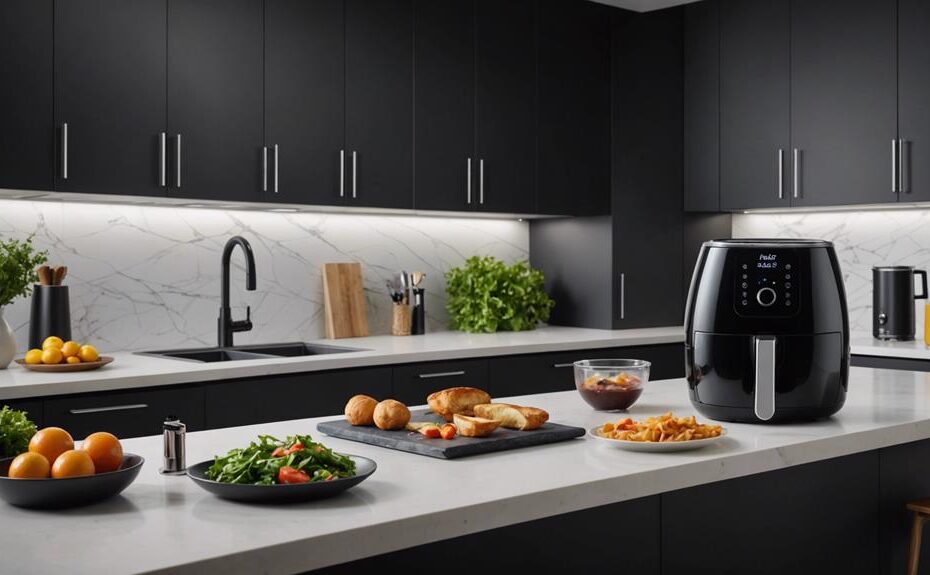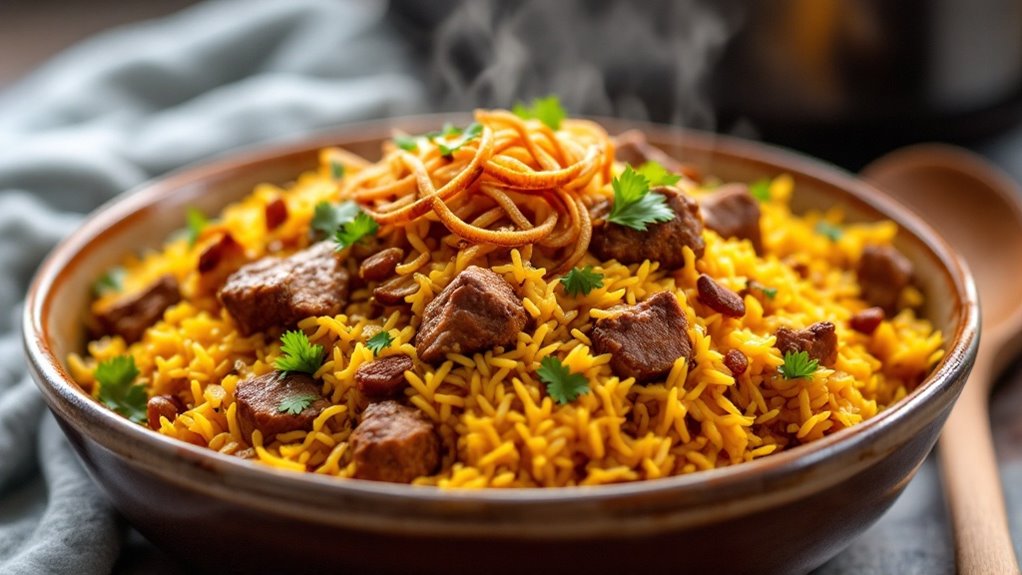Air fryers aren't expensive to operate. They use 1.4 to 1.7 kWh per hour, costing about $0.18 at $0.12 per kWh. In comparison, gas ovens run $0.40 per hour, and electric ovens cost $0.52. Air fryers consume 50% less energy and cut cooking times in half, adding only $0.30 to $0.50 to your monthly bill with daily use. Their efficiency means significant savings on utility bills. Choosing the right size and avoiding overuse optimizes energy consumption. Interested in learning the technical details and maximizing your savings?
Key Takeaways
- Air fryers cost about 25 cents per hour to operate, significantly less than traditional ovens.
- They use 50% less total energy than conventional ovens, making them highly energy-efficient.
- Daily use of an air fryer can add only $0.30 to $0.50 to the monthly electric bill.
- Faster cooking times with air fryers lead to notable savings on utility bills.
- Properly sizing and using an air fryer can optimize energy consumption and cost efficiency.
Energy Consumption of Air Fryers
When evaluating the energy consumption of air fryers, you'll find that they typically use about 3-5 kWh of electricity per hour, depending on the model and size. This means that if you use an air fryer for an hour daily, it can add approximately $0.30 to $0.50 to your monthly electric bill.
Energy consumption in air fryers is more influenced by the cooking time rather than the size of the appliance. Hence, focusing on efficient cooking practices can help reduce overall electricity usage. Choosing the right model and size is vital for managing energy consumption. Smaller models generally consume less electricity, but it's important to match the size to your cooking needs to avoid prolonged usage, which can spike electricity bills.
To further reduce costs, avoid unnecessary or extended usage of the air fryer. Efficiently managing cooking times and ensuring that you're not over-relying on the appliance for every meal can make a significant difference. By being mindful of these factors, you can optimize the energy consumption of your air fryer, thereby reducing your electricity bills while enjoying the benefits of this convenient cooking tool.
Comparing Air Fryers and Ovens
Given the notable differences in energy consumption between air fryers and ovens, it's evident that air fryers offer a more cost-effective cooking solution. When you compare the operating costs, air fryers cost about 25 cents per hour, while gas ovens run at 40 cents per hour and electric ovens at 52 cents per hour. This substantial reduction in electricity usage translates to considerable savings over time.
Air fryers are designed to use about 50% less total energy compared to traditional ovens. This increased efficiency means that, not only are you cutting down on electricity costs, but you're also reducing overall energy consumption. Wall ovens, known for their less efficient energy use, further highlight the cost benefits of air fryers.
In terms of cooking efficiency, air fryers greatly reduce cooking time compared to standard ovens. This faster cooking time means you're using less energy per meal, directly impacting your utility bills. In a year, the cumulative savings can amount to hundreds of dollars. The data-driven comparison clearly shows that air fryers, with their lower energy consumption and operational costs, provide a more efficient and economical cooking solution.
Cost per Kwh Analysis
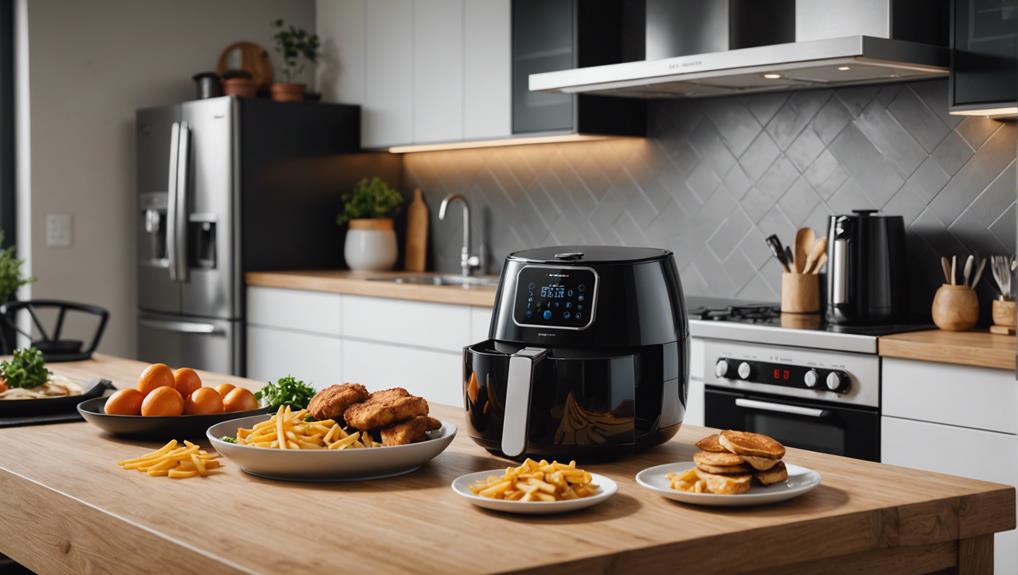
To analyze the cost per kWh of operating an air fryer, you need to multiply the energy price per kWh by the air fryer's kWh usage. For instance, if your air fryer uses 1.5 kWh per hour and the average energy cost is $0.12 per kWh, the operating cost is $0.18 per hour. If you use the air fryer for 30 minutes daily, the daily cost is approximately $0.09, resulting in a monthly energy bill increase of about $2.70.
Air fryers typically use between 1.4 to 1.7 kWh per hour, depending on the model and size. By understanding your air fryer's kWh usage, you can better estimate the energy consumption and subsequent operating cost. Analyzing these factors allows you to identify potential energy savings and manage your energy bill more effectively.
Additionally, selecting the right size air fryer for your needs can optimize energy consumption, leading to further energy savings. A larger air fryer might have a higher kWh usage, but it could be more efficient for larger meals, reducing overall cooking time. Conversely, a smaller air fryer might suffice for single servings, minimizing the energy cost per meal.
Cooking Time Efficiency
Air fryers greatly reduce cooking time by eliminating the need for preheating and cooking food faster than traditional ovens. This efficiency is due to the rapid air circulation technology that air fryers use, which guarantees even cooking and browning. By cutting out the preheating requirement, you're already saving several minutes each time you cook.
Furthermore, air fryers can cook food in approximately half the time it would take in a traditional oven. For instance, a dish that would take 30 minutes in an oven might only need 15 minutes in an air fryer. This reduction in overall cooking time translates to increased efficiency, allowing you to prepare meals quicker.
The quicker cooking times result in notable energy savings. Because air fryers operate for shorter durations, they consume less electricity overall. This makes them a cost-effective option for daily cooking needs. Additionally, their compact size means that they use less energy to heat up compared to the larger capacity of traditional ovens.
Electricity Savings Potential
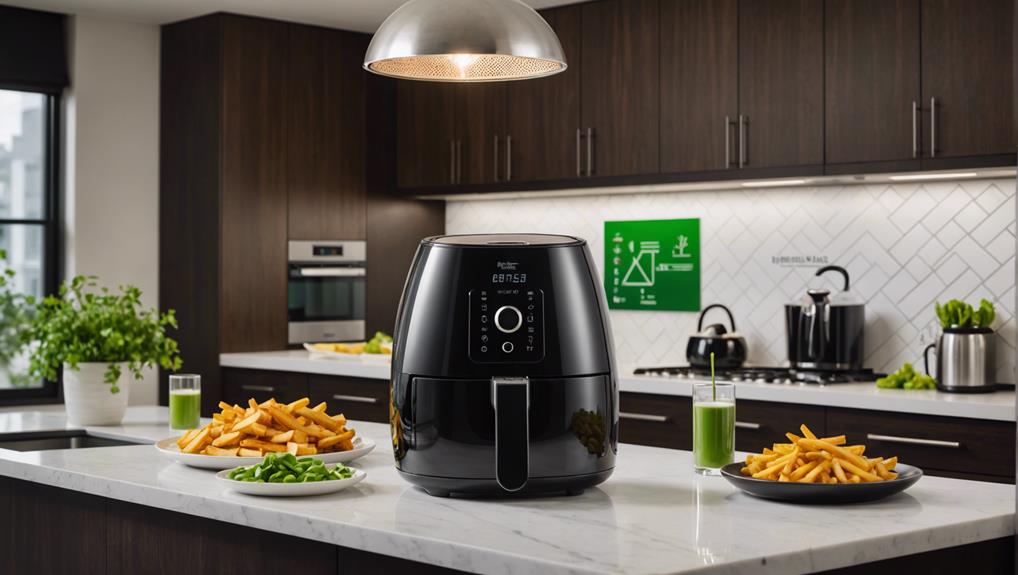
Leveraging rapid air circulation, air fryers consistently use about 50% less total energy than conventional ovens, greatly reducing electricity costs. This substantial reduction in energy consumption makes air fryers a highly energy-efficient and cost-effective cooking appliance. When you operate an air fryer, it generally costs about 25 cents per hour, compared to the 40 cents per hour for gas ovens and 52 cents per hour for electric ovens.
The lower operating costs of air fryers stem from their efficient design and quicker cooking times. Traditional ovens, by contrast, require more energy to heat up and maintain temperature, leading to higher electricity usage. Over time, these differences translate into substantial utility savings. For instance, switching from a traditional electric oven to an air fryer could save you hundreds of dollars annually in electricity costs.
Moreover, air fryers are cheaper to run, offering a practical solution for households looking to cut down on their energy bills. By opting for an air fryer, you can not only enjoy the benefits of energy-efficient cooking but also significantly reduce your overall operating costs, making it a wise investment for cost-conscious consumers.
Air Fryer Versus Gas Oven
When you compare the operating costs, it's evident that air fryers are much more energy-efficient than gas ovens, costing about 25 cents per hour versus 40 cents per hour. This notable difference in operating costs translates directly into substantial savings on your electricity bill. By using an air fryer, you can cut your energy consumption by approximately 50% compared to a gas oven. This efficiency makes air fryers a cost-effective choice for your kitchen.
In terms of annual utilities, operating an air fryer instead of a gas oven can save you hundreds of dollars. If you frequently cook at home, these savings add up quickly. The lower energy consumption of air fryers not only reduces your electricity bill but also contributes to a smaller carbon footprint. This makes air fryers an attractive option for the environmentally conscious consumer.
When making a comparison between an air fryer and a gas oven, it's clear that the air fryer is more energy-efficient and cost-effective. The reduced operating costs and energy consumption make it a practical choice for anyone looking to maximize their savings and efficiency in the kitchen.
Tips to Maximize Savings
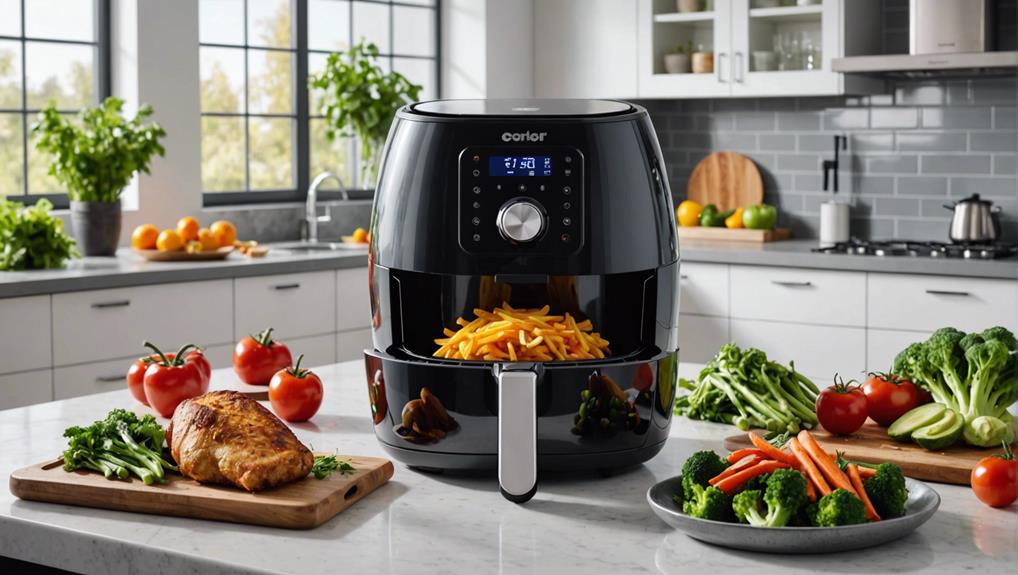
To maximize savings, preheat your air fryer before cooking to reduce overall cooking time and enhance energy efficiency. Preheating ensures that the air fryer reaches the best temperature faster, reducing the time it needs to run and thereby lowering operating costs.
Using the correct settings for different types of food can also greatly optimize energy usage. Each food type has an ideal temperature and cooking time; adhering to these guarantees efficient operation and maximizes cost savings. Additionally, avoid opening the air fryer door while cooking. Maintaining a consistent temperature minimizes energy waste, ensuring the appliance doesn't overwork to regain lost heat.
Unplugging the air fryer when not in use is another simple measure to save on standby power. Even when not actively cooking, plugged-in appliances draw a small amount of electricity, which can add up over time.
Lastly, properly sizing the air fryer for the food being cooked is important. Overloading the appliance can lead to longer cooking times and reduced energy efficiency. Conversely, using a too-large air fryer for small portions wastes energy. By considering these factors, you can optimize your air fryer's usage and achieve significant cost savings.
Environmental Impact
Air fryers significantly reduce environmental impact by consuming about 50% less energy than traditional ovens. This energy efficiency translates into significant energy savings and cost-effective operation. For instance, operating an air fryer costs around 25 cents per hour, whereas gas ovens and electric ovens cost 40 cents and 52 cents per hour, respectively. By using an air fryer, you'll not only lower your total energy consumption but also enjoy substantial utilities savings.
Given their lower total energy usage, air fryers emerge as a greener cooking option compared to conventional wall ovens. This shift to air fryers can lead to a reduced carbon footprint, aligning with environmentally conscious living. Studies show that households can save hundreds of dollars annually on their utility bills by choosing air fryers over traditional ovens.
The reduced operating costs of air fryers further support their role in minimizing environmental impact. By integrating air fryers into your cooking routine, you contribute to energy conservation and lower greenhouse gas emissions. Overall, air fryers offer an effective solution for those seeking both economic benefits and environmental responsibility in their kitchen practices.
Frequently Asked Questions
Does an Air Fryer Increase the Electricity Bill?
Using an air fryer will increase your electricity bill, but the impact is minimal. Its energy consumption depends on wattage and usage patterns. A cost analysis shows operational costs range from $0.30-$0.50 monthly, reflecting efficient electrical usage.
Is It Cheaper to Run an Air Fryer Than an Oven?
Yes, it's cheaper to run an air fryer than an oven. Air fryers excel in cooking efficiency, heat distribution, and lower energy consumption. They also offer better power usage, extended appliance lifespan, and improved food texture with frequent meal preparation.
What Is the Downside of an Airfryer?
While air fryers offer health benefits, they're plagued by limited capacity, uneven cooking, and noisy operation. You'll face cleaning maintenance, food dehydration, and plastic component wear. Space requirements, a learning curve, and potential warranty issues further complicate ownership.
Why Are People Getting Rid of Air Fryers?
You're getting rid of air fryers due to health concerns, space limitations, limited recipes, and cooking capacity. Maintenance hassle, noise levels, heat emissions, durability issues, taste differences, and tech complexity also play significant roles in this decision.
Conclusion
To sum up, you'll find that air fryers are not only efficient but also cost-effective compared to traditional ovens. Analyzing the data, air fryers consume less energy and operate at a lower cost per kWh. With faster cooking times, they offer substantial electricity savings. By optimizing usage, you can further maximize efficiency. Think of it as turning your kitchen into a well-oiled machine, minimizing both costs and environmental impact.
Disclosure: As an Amazon Associate, I earn from qualifying purchases.
